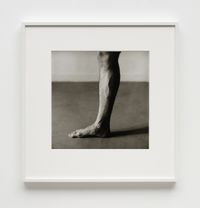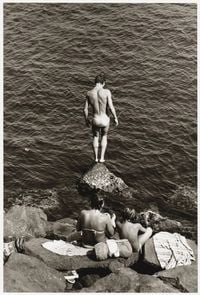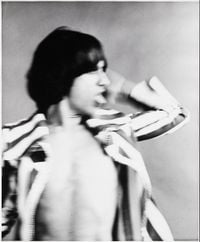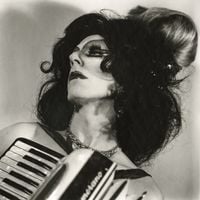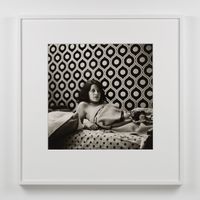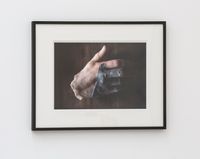An icon of the bohemian scene in 1970s and early 80s New York, Peter Hujar is known for his subversive oeuvre of black-and-white photography. His countless square format works are direct, yet rendered with evocative tonal contrasts enhanced through his meticulous darkroom process. Among his subjects are scenes of death, the margins of New York's nightlife, cityscapes, landscapes, and intimate pictures of close friends and lovers.
Read MoreBorn to a waitress in New Jersey, Peter Hujar had a troubled upbringing that was marred by verbal and physical abuse. He left home at the age of 16 to live with his English teacher, the free-spirited poet Daisy Aldan.
Encouraged by Aldan to seriously pursue a career in photography, Hujar began his career in commercial photography, doing fashion shoots for Harper's Bazaar and GQ. Soon forsaking the relative financial security of professional photography, Hujar turned his full focus to his own artistic work in the late 1960s.
In his free time, Peter Hujar soaked up the advice of some of the pioneers of his time. He attended 'Master Class' seminars taught by leading American photographers Diane Arbus and Richard Avedon. Arbus had been taught by Austrian-American street photographer Lisette Model, whose intimate street portraits served as another early influence for Hujar.
As his career developed, Peter Hujar influenced and was influenced by his contemporaries, who included Pop artist Andy Warhol and writers Susan Sontag and Fran Lebowitz. There was also mutual influence between Hujar and fellow artist and lover David Wojnarowicz, his long-time muse and companion. Hujar also influenced the work of younger contemporaries like Nan Goldin and Robert Mapplethorpe.
One of Peter Hujar's earliest bodies of artistic work are the photographs he took of the Palermo catacombs. Taken in 1963 on a visit to Italy, the series starkly and uncompromisingly presents the mummified inhabitants of the tombs. Mortality continued to persist as a theme throughout the artist's work. An example of Hujar's fascination with death is Candy Darling on her Deathbed (1973), a photograph of the titular transgender performer, then dying of lymphoma, striking a theatrical death pose in her hospital bed.
In 1969, Hujar also began to explore animals as artistic subject matter. Horse in West Virginia Mountains (1969) marked the first image in what became a long-running extension of Hujar's portrait photography.
Many of Peter Hujar's best known images were shown in Speed of Life, an exhibition that travelled across several European and American institutions and featured over 160 photographs taken between 1970 and 1987. As an insider to the bohemian scene of the time, Hujar's portraiture in this body of work captures a distinct period in New York's alternative cultural history, bookended by the Stonewall riots of 1969 and the AIDS crisis that claimed Peter Hujar's own life in 1987.
Peter Hujar's photos include behind-the-scenes shots of the various drag acts, avantgarde performances, and alternative theatre groups that defined the city's downtown nightlife. These empathetically represent characters like the gender-bending theatrical troupe, The Cockettes, Charles Ludlam of the Ridiculous Theatre Company, and singer, actor, and drag queen Glenn 'Divine' Milstead.
Hujar did not photograph these people as freaks or curiosities, but rather celebrated them as individuals pushing boundaries and embracing the freedom to be themselves. As Ocula Magazine explains, 'when heteronormative gender roles were blasted into televisions around the U.S.A., Hujar shone a light on those playing against the patriarchy.' Peter Hujar also famously documented the gay scene that was active around the piers on the Hudson, a cruising spot he himself frequented.
In his studio loft in the East Village, Peter Hujar took portraits of friends and counter-cultural icons alike. Captured with a direct simplicity, without care for age or body types, these images range from jovial or sincere portraits to erotic nudes.
Within the Peter Hujar archive is an array of portraits of figures in the downtown creative scene. Alongside intimate pictures of close acquaintances, like Wojnarowicz, Sontag, and Lebowitz, one can find studio shots of Andy Warhol, Merce Cunningham, John Cage, William Burroughs, John Waters, Iggy Pop, and Kiki Smith, among others. Among these are also a number of Peter Hujar's self-portraits, which present the artist with the same playful but direct intimacy.
Beyond his intimate portraits, Peter Hujar's seminal body of work also includes brooding photographs of the countryside; dark Manhattan cityscapes; dilapidated structures, such as the derelict piers along the Hudson; and countless renderings of the waves of the Hudson River.
Peter Hujar's prints can be found in such institutions as the Tate London; Museum of Modern Art (MoMA), New York; the J. Paul Getty Museum, Los Angeles; Whitney Museum of American Art, New York; and the Art Institute of Chicago.
Although Peter Hujar, by choice, held few exhibitions during his lifetime, his work has since been the subject of several posthumous museum shows and retrospectives worldwide.
Peter Hujar's solo exhibitions include Peter Hujar: Speed of Life, The Morgan Library & Museum, New York (2018); Peter Hujar, Institute of Contemporary Arts, London (2007); Peter Hujar, MoMA P.S.1, New York (2005); Peter Hujar: A Retrospective, Stedelijk Museum, Amsterdam, (1994); Peter Hujar, Grey Art Gallery and Study Center, New York (1990); Peter Hujar, Kunsthalle Basel (1982); Peter Hujar, Catskill Center for Photography, Woodstock (1977).
Peter Hujar's group exhibitions include Masculinities: Liberation through Photography, Barbican Centre, London (2020); Glam! The Performance of Style, Tate Liverpool (2013); Regarding Warhol: Sixty Artists, Fifty Years, The Metropolitan Museum of Art, New York (2012); The History of Photography, Tokyo Metropolitan Museum of Photography (2005); Pictures of the Real World (In Real Time), Hara Museum of Contemporary Art, Tokyo (1995); Portraits, Centre d'Art Contemporain, Geneva (1980); Contemporary Photography, Baltimore Museum of Art (1977).
Michael Irwin | Ocula | 2021
